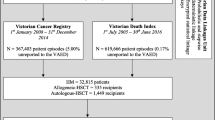Abstract
Purpose
The literature on the impact of infectious disease (ID) consulations in the outpatient treatment of cancer is scarce.
Methods
The medical records of consecutive adult patients with cancer formally evaluated by two board-certified ID specialists in an outpatient setting at our institution over a 10-year period (1998–2008) were reviewed retrospectively. The patients' demographics, referring departments, purposes for consultation, ID specialist recommendations, and overall impact of consultations on outcome were analyzed.
Results
We identified 598 patients who underwent ID specialist consultations. Most of them had solid tumors (53%), predominantly breast cancer, whereas non-Hodgkin's lymphoma was the most common hematologic malignancy. Almost half of the patients (45%) had active malignancies, but few of them were severely neutropenic (8%) or had been receiving high doses of corticosteroids (17%). The most frequent requests for consultation were culture or serologic test (15%), and treatment of cellulitis and/or surgical wound infections (14%). Of 337 isolated pathogens, the most prevalent were methicillin-resistant Staphylococcus aureus (13%) and Pseudomonas aeruginosa (8%), as well as atypical mycobacteria (16%) and Aspergillus species (11%). ID specialists provided alternative diagnoses in 53% of the cases, including identification of a different infection (46%), a noninfectious etiology (29%), colonization (16%), and drug-related toxic effects (9%). Overall, we deemed the contribution of the ID specialist to be significant in 62% of the consultations.
Conclusions
ID specialists contribute significantly to the outpatient care of individuals with cancer.

Similar content being viewed by others
References
Sipsas NV, Bodey GP, Kontoyiannis DP (2005) Perspectives for the management of febrile neutropenic patients with cancer in the 21st century. Cancer 103:1103–1113
Maschmeyer G, Haas A (2008) The epidemiology and treatment of infections in cancer patients. Int J Antimicrob Agents 31:193–197
Arias CA, Murray BE (2009) Antibiotic-resistant bugs in the 21st century—a clinical super-challenge. N Engl J Med 360:439–444
Gootz TD (2010) The global problem of antibiotic resistance. Crit Rev Immunol 30:79–93
Leventakos K, Lewis RE, Kontoyiannis DP (2010) Fungal infections in leukemia patients: how do we prevent and treat them? Clin Infect Dis 50:405–415
Kontoyiannis DP, Marr KA, Park BJ, Alexander BD, Anaissie EJ, Walsh TJ, Ito J, Andes DR, Baddley JW, Brown JM, Brumble LM, Freifeld AG, Hadley S, Herwaldt LA, Kauffman CA, Knapp K, Lyon GM, Morrison VA, Papanicolaou G, Patterson TF, Perl TM, Schuster MG, Walker R, Wannemuehler KA, Wingard JR, Chiller TM, Pappas PG (2010) Prospective surveillance for invasive fungal infections in hematopoietic stem cell transplant recipients, 2001–2006: overview of the Transplant-Associated Infection Surveillance Network (TRANSNET) database. Clin Infect Dis 50:1091–1100
Vidal L, Paul M, Ben dor I, Soares-Weiser K, Leibovici L (2004) Oral versus intravenous antibiotic treatment for febrile neutropenia in cancer patients: a systematic review and meta-analysis of randomized trials. J Antimicrob Chemother 54:29–37
Petrak RM, Sexton DJ, Butera ML et al (2003) The value of an infectious diseases specialist. Clin Infect Dis 36:1013–1017
Grupper M, Potasman I (2008) Formal adult infectious disease outpatient consultations: a retrospective 6-year survey. Infection 36:543–548
Oken MM, Creech RH, Tormey DC, Horton J, Davis TE, McFadden ET, Carbone PP (1982) Toxicity and response criteria of the eastern cooperative oncology group. Am J Clin Oncol 5:649–655
Doern GV, Vautour R, Gaudet M, Levy B (1994) Clinical impact of rapid in vitro susceptibility testing and bacterial identification. J Clin Microbiol 32:1757–1762
Gómez J, Conde Cavero SJ, Hernández Cardona JL, Núñez ML, Ruiz Gómez J, Canteras M, Valdés M (1996) The influence of the opinion of an infectious disease consultant on the appropriateness of antibiotic treatment in a general hospital. J Antimicrob Chemother 38:309–314
Nathwani D, Davey P, France AJ, Phillips G, Orange G, Parratt D (1996) Impact of an infection consultation service for bacteremia on clinical management and use of resources. QJM 89:789–797
Elhanan G, Sarhat M, Raz R (1997) Empiric antibiotic treatment and the misuse of culture results and antibiotics sensitivities in patients with community-acquired bacteremia due to urinary tract infection. J Infect 35:283–288
Byl B, Clevenbergh P, Jacobs F, Struelens MJ, Zech F, Kentos A, Thys JP (1999) Impact of infectious diseases specialists and microbiological data on the appropriateness of antimicrobial therapy for bacteremia. Clin Infect Dis 29:60–66
Fluckiger U, Zimmerli W, Sax H, Frei R, Widmer AF (2000) Clinical impact of an infectious disease service on the management of bloodstream infection. Eur J Clin Microbiol Infect Dis 19:493–500
Yinnon AM (2001) Whither infectious diseases consultations? Analysis of 14,005 in a 5-year period. Clin Infect Dis 33:1661–1667
Borer A, Gilad J, Meydan N (2004) Impact of regular attendance by infectious disease specialists on the management of hospitalised adults with community-acquired febrile syndromes. Clin Microbiol Infect 10:911–916
Honda H, Krauss MJ, Jones JC, Olsen MA, Warren DK (2010) The value of infectious diseases consultation in Staphylococcus aureus bacteremia. Am J Med 123:631–637
Schlech WF 3rd (1995) The practice of infectious diseases in the 1990s: the Canadian experience. Clin Infect Dis 20:291–295
Cooksley CD, Avritscher EBC, Rolston KV, Elting LS (2009) Hospitalization for infection in cancer patients: impact of an aging population. Support Care Cancer 17:547–554
Conflicts of interest
None
Author information
Authors and Affiliations
Corresponding author
Additional information
G. Pongas and G. Hamilos contributed equally to this study.
Rights and permissions
About this article
Cite this article
Pongas, G., Hamilos, G., Rolston, K.V. et al. Formal adult infectious disease specialist consultations in the outpatient setting at a comprehensive cancer center (1998–2008): Diverse and impactful. Support Care Cancer 20, 261–265 (2012). https://doi.org/10.1007/s00520-010-1065-9
Received:
Accepted:
Published:
Issue Date:
DOI: https://doi.org/10.1007/s00520-010-1065-9



